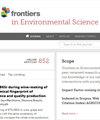Numerical modeling the impacts of increasing groundwater pumping upon discharge decline of the BL Spring located in Xilin Gol League in east inner Mongolia, China
IF 3.3
3区 环境科学与生态学
Q2 ENVIRONMENTAL SCIENCES
引用次数: 0
Abstract
Spring discharge decline induced by increasing groundwater pumping under the background of increasing water demand for agricultural, industrial, and domestic utilizations has been recognized as a significant geo-environmental issue which poses a great threat to springshed eco-environmental safety. In this study, numerical approach was utilized and a series of 3D groundwater flow models based on the MODFLOW module were developed to simulate current-stage and future trends of spring discharges under the impacts of increasing groundwater pumping due to the rapid development of tourism in the BL spring located in Xilin Gol League in east Inner Mongolia (China), for the purpose of understanding the responses of spring discharges to various groundwater pumping scenarios in future. Simulation results indicated that: (1) spring discharge has reduced from 201.4 m中国内蒙古东部锡林郭勒盟 BL 泉数值模拟地下水抽水量增加对排水量下降的影响
在农业、工业和生活用水需求不断增长的背景下,地下水抽取量的增加导致泉水排放量下降,这已被认为是一个重大的地质环境问题,对泉域生态环境安全构成了巨大威胁。本研究利用数值方法,基于 MODFLOW 模块建立了一系列三维地下水流模型,模拟了位于中国内蒙古东部锡林郭勒盟的 BL 泉在旅游业快速发展导致地下水抽取量增加的影响下,泉水出水量的现阶段和未来变化趋势,以了解泉水出水量对未来各种地下水抽取情景的响应。模拟结果表明(1) 在现阶段抽水方案下,泉水排放量从 201.4 m3/d 减少到 193.7 m3/d(减少率为 3.80%);(2) 在现阶段抽水方案下,泉水排放量影响区为 2.(2) 在現階段的抽水計劃下,受泉水排放影響的地區面積為 2.025 平方公里,在這區域抽取地下水會導致泉水排放減少;(3) 距離草坪嶺泉眼最近的抽水井所造成的影響最為顯著,而距離草坪嶺泉眼最遠的抽水井所造成的影響則可忽略不計;以及 (4) 若七口抽水井的總抽水量由每日 45.8 立方米(現階段)增至 193.7 立方米(減幅比率為 3.80%),泉水排放將會分別減少 25%、50%、75% 和 100%。(4) 如果七口抽水井的總抽水量由每日 45.8 立方米(現階段抽 水計劃)增至 297.7、586.2、888.5 和 1,176 立方米,泉水排 放量便會分別減少 25%、50%、75%和 100%。本研究成果可为在泉水排放管理和生态环境保护的前提下,提出可持续的地下水开发利用策略,满足地下水供应需求提供有益的参考。
本文章由计算机程序翻译,如有差异,请以英文原文为准。
求助全文
约1分钟内获得全文
求助全文
来源期刊

Frontiers in Environmental Science
Environmental Science-General Environmental Science
CiteScore
4.50
自引率
8.70%
发文量
2276
审稿时长
12 weeks
期刊介绍:
Our natural world is experiencing a state of rapid change unprecedented in the presence of humans. The changes affect virtually all physical, chemical and biological systems on Earth. The interaction of these systems leads to tipping points, feedbacks and amplification of effects. In virtually all cases, the causes of environmental change can be traced to human activity through either direct interventions as a consequence of pollution, or through global warming from greenhouse case emissions. Well-formulated and internationally-relevant policies to mitigate the change, or adapt to the consequences, that will ensure our ability to thrive in the coming decades are badly needed. Without proper understanding of the processes involved, and deep understanding of the likely impacts of bad decisions or inaction, the security of food, water and energy is a risk. Left unchecked shortages of these basic commodities will lead to migration, global geopolitical tension and conflict. This represents the major challenge of our time. We are the first generation to appreciate the problem and we will be judged in future by our ability to determine and take the action necessary. Appropriate knowledge of the condition of our natural world, appreciation of the changes occurring, and predictions of how the future will develop are requisite to the definition and implementation of solutions.
Frontiers in Environmental Science publishes research at the cutting edge of knowledge of our natural world and its various intersections with society. It bridges between the identification and measurement of change, comprehension of the processes responsible, and the measures needed to reduce their impact. Its aim is to assist the formulation of policies, by offering sound scientific evidence on environmental science, that will lead to a more inhabitable and sustainable world for the generations to come.
 求助内容:
求助内容: 应助结果提醒方式:
应助结果提醒方式:


